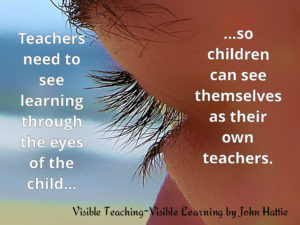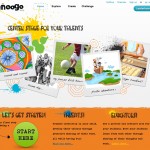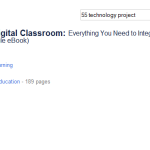
April 29, 2018
Visible Learning and John Hattie
 Over the years, I’ve struggled to teach in ways my students would understand. Standing at the front of the classroom stopped working so I researched (and tried in some cases) Whole Brain Teaching (WBT), Socratic Method, Understanding by Design, Mindfulness, and a lot more options that colleagues mentioned as helpful with their differentiated student groups. They all worked for a while and then, maybe when the novelty wore off, I was back to the same Bell curve of successes, failures, and those in between.
Over the years, I’ve struggled to teach in ways my students would understand. Standing at the front of the classroom stopped working so I researched (and tried in some cases) Whole Brain Teaching (WBT), Socratic Method, Understanding by Design, Mindfulness, and a lot more options that colleagues mentioned as helpful with their differentiated student groups. They all worked for a while and then, maybe when the novelty wore off, I was back to the same Bell curve of successes, failures, and those in between.
The same could be said of Standards and curricula adopted in my varied teaching gigs. That includes everything from Common Core to the IB philosophy, from Depth of Knowledge to Project-based Learning. I confess, I found it frustrating. Everything worked for a while and nothing worked in the long term.
That’s when I heard about John Hattie at an education conference I attended and his concept of Visible Learning. John Hattie is a teacher but more significantly, he’s an education researcher. His life’s goal is to determine what education strategies work best for the largest number of students. He engaged in a fifteen-year evaluation of over 50,000 research articles and something like 240 million students — making it the biggest evidence-based education research project ever — and discovered something no one expected and few believed: Almost any approach will work if delivered well. The one foundational element required for success is passionate, involved, committed, flexible teachers:
“The remarkable feature of the evidence is that the greatest effects on student learning occur when teachers become learners of their own teaching, and when students become their own teachers.”
How can that be? According to John Hattie, what he came to call “visible learning” happens when we teachers look at what we’re doing:
“Visible teaching and learning occur when there is deliberate practice aimed at attaining mastery of the goal, when there is feedback given and sought, and when there are active, passionate, and engaging people (teacher, students, peers) participating in the act of learning.
Visible refers to making student learning visible to teachers so both parties know it’s working
Learning refers to the need to place learning at the forefront of teaching where it has the greatest impact on students
When the learning is visible the teacher knows if it is occurring. Or not occurring.
His eight mindframes for teachers include:
- My fundamental task is to evaluate the effect of my teaching on students’ learning and achievement.
- The success or failure of my students’ learning is about what I do or don’t do. I am a change agent.
- I want to talk more about learning than teaching.
- Assessment is about my impact.
- I teach through dialogue not monologue.
- I enjoy the challenge and never retreat to “doing my best”.
- It’s my role to develop positive relationships in class and staff rooms.
- I inform all about the language of learning.
None of these have anything to do with teacher training, background, test scores, rubrics, class size, or pay scales. It’s all about a teacher’s passion, commitment, and ability to be the change agent needed. Hattie’s Golden Rule for teachers is: “Know thy impact.”
How students excel in learning
Excellence is all around us and has many faces. Visible Learning focuses on how to learn, not the constructs like sitting quietly and starting school at 8 a.m. The key is that learning comes from the students. They assess their learning, determine if it’s succeeding, and decide what to do about it. They become what Hattie calls “assessment-capable”. That means students see themselves as their own teachers. They are empowered and held responsible.
It’s interesting to note, in all of Hattie’s voluminous research, the big effects on whether students thrive are:
- student self-reporting grades
- teacher clarity
- reciprocal teaching
- feedback
- teacher-student relationships
- self-verbalization/questioning
- teacher professional development
- problem-solving teaching
What doesn’t much matter
You may want to skip this section because it includes conclusions many teachers and parents will disagree with — loudly. In fact, many are the pivotal criteria cited by “experts” as predictors of learning. I’ve picked a few that are hot buttons among US educational elite but click to see the entire list. Here’s what Hattie’s distillation of hundreds of studies involving hundreds of thousands of students said didn’t much matter:
- class size
- charter schools
- homework
- teacher education
- ability grouping
Education applications
Overall, there are a few suggestions that overlay everything:
- Don’t change what’s working.
- Don’t engage tracking with students. How do you defend that they’re stuck in a certain track and that’s where they belong. Where’s the equity with that?
- Subjects like art and music — though they show little value in overall student success — are valuable in and of themselves. That’s enough.
***
What it gets down to is simply good teaching. Worry less that you aren’t up to the job (because of PD or classes or whatever else crosses your mind) and more about the students.
–poster credit: https://goo.gl/images/JPbQyJ
More on John Hattie:
Jacqui Murray has been teaching K-8 technology for 20 years. She is the editor/author of over a hundred tech ed resources including a K-8 technology curriculum, K-8 keyboard curriculum, K-8 Digital Citizenship curriculum. She is an adjunct professor in tech ed, CSG Master Teacher, webmaster for four blogs, an Amazon Vine Voice reviewer, CAEP reviewer, CSTA presentation reviewer, freelance journalist on tech ed topics, and a weekly contributor to TeachHUB. You can find her resources at Structured Learning. Read Jacqui’s tech thriller series, To Hunt a Sub and Twenty-four Days.






